
The start point for the best source of fleet information |
Final report: Audi A3 long-term test
Date: 21 April 2021 | Author: Sean Keywood
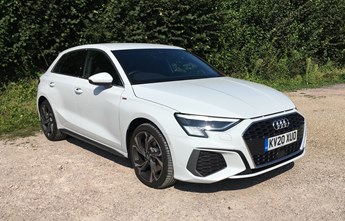
|
|
||||||||||||
Final Report: The case for the diesel defence
In our long-term test of the Audi A3, we set out to answer the question of whether it makes sense as a diesel premium hatchback. Well, now that it's left our fleet, we have to conclude that the answer to the first part of that question is a resounding yes.
An average economy figure on test of 61mpg, an improvement on the official WLTP figure, is superb, as is the way it allowed an average of nearly 600 miles between visits to filling stations. Admittedly, my heavily reduced mileage during the latest lockdown may mean the A3 sidestepped the same winter decline in efficiency that Business Car editor Simon Harris reported from his Volkswagen Passat diesel, with the same engine. But even so, it's hard to avoid the conclusion that, despite diesel car sales continuing to plummet - they accounted for just 13.2% of UK registrations in February - for company drivers doing long motorway journeys, the fuel still makes a lot of sense. There's no shortfall in performance either - at 150hp it's not a hot hatch, but has more than enough shove for regular motoring and can pin you back in your seat if required, with an impressive 360Nm torque figure aiding in-gear acceleration.
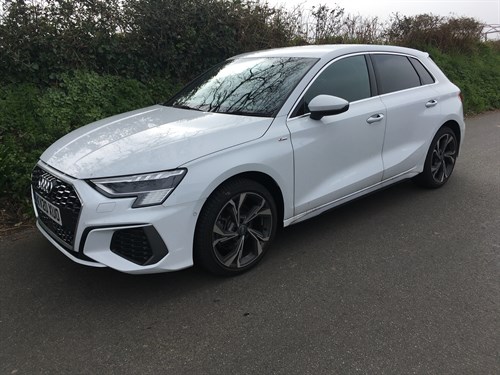
So, that's a thumbs up for diesel - what about the premium hatch element? Well, there's no doubt that the A3's high-quality interior feels like a premium product - and having tested the latest Volkswagen Golf, I can also confirm that the A3 is a definite step up compared with its platform-sharing cousin in terms of the materials used. And the A3 does a lot of other things well. The infotainment system is highly accomplished, with the excellent Virtual Cockpit driver display (with integrated Google Earth mapping) paired with a 10.1in touchscreen, while the A3 thankfully also retains physical controls for the ventilation system. And the combination of adaptive cruise control and automatic transmission made long distance travelling a piece of cake, as did the comfortable seats and the 'standard' suspension, fitted as a no-cost option rather than the firmer S Line set-up.
However, while overall in its time with us the A3 has impressed, it's difficult for me to pick out any real wow factor, which, considering the cost of our test car with options came to over £37,000, is a disappointment. Although, in standard spec its price matches up well with premium rivals the BMW 1 Series and Mercedes-Benz A-Class.
For me, personally, it's hard to compare the A3 favourably with the Mazda3 hatch I ran on our fleet in 2019, which also boasts a superb interior, and is better to drive and, in my opinion, more stylish. But there is one major flaw - Mazda no longer makes that car with a diesel engine. Deeply unfashionable it may be, but from a fleet perspective, that highly-efficient unit under the bonnet - which also just shades the BMW and Merc in official economy testing - might be the A3's best trump card.
6th Report: A trip from memory lane
For obvious reasons, the Business Car A3 hasn't done very many miles recently. In fact, the odometer tells me that it's done precisely two miles since our last update. So, instead, let me invite you to take a trip back in time, to August 2020, when my dad and I used the A3 for a 200-mile trip to spend a weekend watching classic motor racing, which was permitted by pandemic restrictions at the time - it's not too difficult to stay 2m away from other people when spaced out around a 2.4-mile race track.
The A3's boot had no trouble swallowing our suitcases, rucksacks with supplies, and changes of footwear. Although, our camping chairs did have to go on the back seat (in the Audi's defence, this was before I knew the boot floor could be lowered - see January's update for more details). On the journey up, we benefited from the A3's favourable ride quality and also the on-board sat-nav rerouting us around a known traffic jam trouble point - although, it has to be said, the rather long-winded route it took to do this made us question its worth a bit. Still, it's the old satnav traffic dilemma - you never see how bad the hold-up was you were avoiding, meaning you can never really judge the worth of the diversion. And anyway, the combination of adaptive cruise control and automatic gears takes much of the hassle out of stop-start traffic conditions.
Once at our destination, the A3 had no trouble getting in and out of the grassy field car parks, with the sporty bodywork of our S Line spec car not proving any hindrance. We did come across one annoyance, however, on leaving the circuit - the A3 doesn't allow you to type in sat-nav instructions while on the move, insisting you resort to its handwriting recognition feature instead. Even if that makes sense as a safety feature - and Audi must think it does - it's a bit irritating if you have a front seat passenger, who could easily type in the instructions for you but is unable to do so - particularly if, as in my dad's case, your handwriting turns out to be unintelligible as far as the A3's infotainment system is concerned.
Overall though, the A3 proved itself to be a good vehicle for a trip away, with particular thanks to its unfashionable diesel engine, which allowed us to complete the 400-mile round trip, as well as the hops to and from the circuit for two days, without needing to refuel once. Here's hoping that we'll all be able to enjoy such trips away again before too long. Although, with the A3's time with Business Car approaching its end, it's more likely that I'll be doing them in a different vehicle, which will have a high standard to match.
5th Report: Higher or lower?
When I first took delivery of our A3, I found the boot to be slightly smaller than I was expecting. It certainly wasn't pokey, and the high level of the floor came close to the opening, which made unloading heavy items easier. However, I was still expecting a little bit more space, and it felt smaller than the 380 litres quoted on the spec sheet. It seemed especially perplexing since there was an unused space below the boot, above where a spare wheel would go. Why, I wondered, didn't they fit an adjustable boot floor?
Well, it turns out the fault was all mine, and the A3 does have an adjustable boot floor after all. I think my confusion arose because on previous test cars I've had with this feature, the floor has slid into a bracket with two obviously distinct higher and lower slots in it. In contrast, the A3's boot floor in the lower position simply slides below the bracket entirely, into a location where, I discovered when I tried it, has nevertheless been designed to slot very securely into place.
So, the full size of the hatchback boot is now available if I need it. But what if that's still not enough for your needs? Well, before Christmas I was able to have a drive in the blue vehicle pictured. This is the saloon version of the A3, which coincidentally I tested in the same S Line equipment grade and with the same 150hp diesel engine as my regular car.
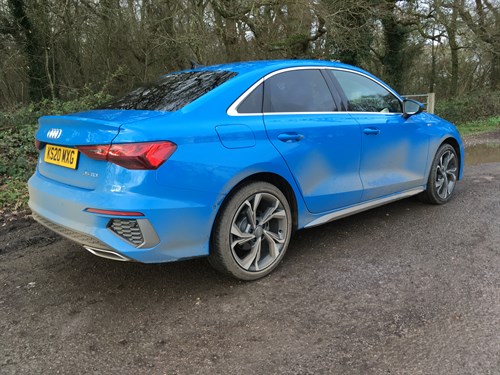
As you'd expect, it would take a forensic examination to detect any changes in the driving experience, since the differences are minor - it's 15cm longer, but with the same width and wheelbase, and only 5kg heavier. But to the point at issue here, it does offer a bigger boot than the Sportback, at 425 litres versus 380. That's a decent chunk of space, although the extra size of course needs to be weighed against the smaller boot opening you inevitably get with the loss of the hatch. Both body styles, except the entry-level version of the hatch, also benefit from 40/20/40 split-folding rear seats, allowing long items to extend through the middle of the bench into the cabin while still accommodating a rear seat passenger either side. Said passengers might be a little less comfortable in the saloon, however, as the roofline is slightly lower - though they'd probably need to be a bit over 6ft tall to be inconvenienced.
There are some other, perhaps less expected, differences if you opt for the saloon. With its more aerodynamic shape, it produces 3g/km less CO2, although this isn't enough to drop it into a lower BIK tax band and it has slightly better fuel economy in official WLTP testing, at 58.9mpg versus the hatch's 57.6mpg (a figure our long-termer is still slightly bettering). On the downside, it's nearly £600 more expensive to buy. Overall then, the choice between them can probably be left to personal taste - but I wouldn't say I was left clamouring to swap out of the Sportback permanently.
4th Report: Living up to the billing?
In the previous update, I praised our Audi A3 for being a comfortable long-distance cruiser. However, readers might have been wondering if this came with a snag - has this comfort come at the expense of driver appeal?
It's a pertinent point given that our A3 is specced in the sporty S-Line equipment grade. This means exterior styling features such as more aggressive bumpers, a roof spoiler and rear privacy glass. I'm a particular fan of the 18in alloy wheels in graphite, which contrast nicely with the Glacier White metallic paint, but sadly those wheels aren't normally available to order in the UK. Interior design features include sport seats, illuminated door sills and stainless steel pedals, and overall it's a package that adds up to some serious kerbside appeal. But is it all just style with no substance, or does the driving experience get somewhere close to the sporty image?
Well, clearly our A3 is no hot hatch - it only has a 150hp diesel engine after all. However, that engine is still perfectly capable of planting you back in your seat if desired, especially when accelerating in-gear, where the benefit is felt of the diesel unit's torque - at 360Nm it's more than 100Nm ahead of the petrol equivalent and, in fact, only 40Nm behind the S3 performance model.
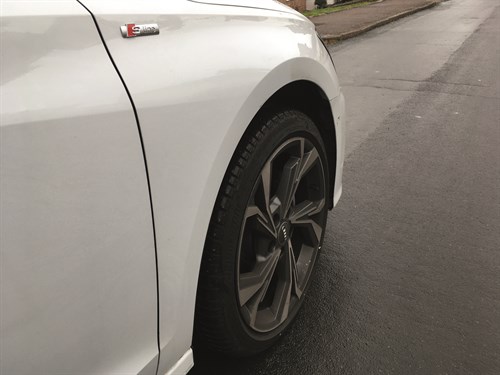
Helping to deploy that shove is the seven-speed DSG automatic gearbox, which kicks down swiftly when pressed, without even needing to resort to the dynamic drive mode. However, do that and a weighting-up of the steering is also triggered, which although not strictly necessary does add a bit of reassurance. There is also the option to shift gears yourself with the steering wheel-mounted paddles, but this doesn't really add enough to the experience to be worth the effort.
I've mentioned before that our car was specced with the A3's standard suspension, available as a no-cost option, rather than the firmer S-Line set-up. This has proved a good choice for long-distance comfort, but I'm happy to confirm it's not a compromise that ruins things when cornering. OK, a slightly tauter front end might be welcome when turning in, but that's nit-picking really, since our A3 handles well overall, and the steering is precise.
Also doing good double duty are the seats, which as well as being comfortable places to cover miles are well bolstered, helping to keep you in place when the road gets twisty.
Overall, while the A3 in this spec isn't the best driver's car in its class, in light of the styling it does well enough to be respectable - and I expect most company car drivers would agree with me that they wouldn't like to see the handling improved if it came at the expense of ride comfort or refinement.
3rd Report: Long-haul flyer
When I took delivery of our long-term A3 a few months ago, I speculated that with its diesel engine and automatic gearbox it would be the ideal tool for my current business travel requirements, with daily commutes to the office a thing of the past and only long-distance trips to car launches scheduled. And I'm happy to report that is exactly how it's proving so far.
We'll start with the engine. Yes, if you can bet on anything in 2020, it's diesel car sales continuing to fall off a cliff. But, blimey, is it satisfying to climb behind the wheel after filling up to be told you have well over 600 miles of range. It means it's entirely possible to do six-hour round trips from the south to jobs in the Midlands without having to refuel once - and who doesn't want to spend as little time as possible in filling stations? That range isn't just down to the size of the fuel tank - calculations show that so far the A3 has achieved real-world fuel economy of 61mpg, which as well as being a highly impressive figure in its own right is also bettering the 57.6mpg figure from the official WLTP test. Bottom line is, this diesel might be an off-trend engine - there's not even a mild-hybrid system to save some electrified face - but it's hard to argue with those fuel savings versus an equivalent petrol car, and there are even plenty of hybrids that would have a job on their hands to match up.
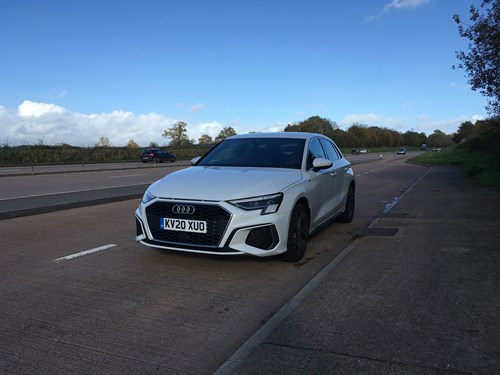
Moving on, there's not too much to say about the seven-speed S Tronic gearbox from a long-distance travel basis, except that it does its job smoothly and is always a godsend when stuck in slow-moving traffic. However, one important function it does perform is to facilitate the adaptive cruise control system, part of the £1,405 driver assistance pack. Opinions are sometimes divided on these, but I'm generally a fan, and the Audi's system is one of the best on the market. For the uninitiated, they allow the car to slow down and speed up based on the speed of traffic in front, even (thanks to the auto) coming to a stop and moving away again, which does so much to reduce stress in jams, and doubles up as a useful safety feature should motorway traffic slow suddenly. An added bonus with our A3's system is that it also works with satnav data, meaning if, for example, there is a sharp bend coming up ahead, it will apply the brakes for you to bring the car down to a safe speed to turn. It will also do this when approaching roundabouts - not bringing the car to a complete stop, but to an appropriate speed to enter if the junction is clear, and to safely stop if it isn't. At first I was sceptical about this feature, thinking it might encourage a driver to tune out and lose concentration, but after a couple of thousand miles I've come down very much in favour, seeing it as just a helping hand that further reduces the mental toll taken by long-distance travelling.
Of course, all this stress-saving kit would count for little if the A3 was uncomfortable, but that's far from the case. The regular suspension, fitted instead of the S-Line's standard sports suspension as a no-cost option, is just the ticket for long journeys, avoiding harshness and absorbing bumps nicely. The sporty S-Line seats, too, might be well bolstered with an eye on cornering, but aren't overly firm, and are a perfectly comfortable place to while away the hours. And if you're worried all this talk of comfort means poor handling, I'll assuage any fears in that direction in a future update.
2nd Report: Keeping in touch
When I heard that Audi had ditched the rotary control from the new A3's infotainment system and had gone touchscreen-only I expected to dislike it. I'm far from alone in thinking that many manufacturers, in making as many functions touchscreen-based as possible, have gone too far, forcing drivers to awkwardly point at a screen and therefore take their eyes off the road while driving, rather than using a more intuitive physical control. Indeed, my two favourite test car infotainment systems during my time at Business Car, fitted to the Mini Hatch and Mazda3, both feature a rotary control set-up.
However, I've found the A3's system to be much easier to use than I expected. Chiefly, I think this is because my usual reason for operating a screen on the move is to switch between the satnav map and the audio system controls, but with Audi's superb Virtual Cockpit display I can have the (Google Earth) satellite map in the instrument cluster the whole time, leaving the central screen free for the stereo (or if you prefer you can switch between the functions on the Virtual Cockpit screen with the steering wheel controls).
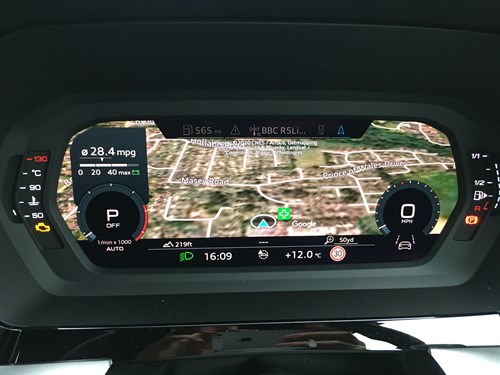
In addition, Audi has, at least with the A3, avoided the pitfall of putting ventilation system controls on the screen, meaning that these can be adjusted with good-old physical buttons. There's also the option to use voice control, but personally I find this too much of a faff to use most of the time given how much confirmation it needs for commands, though it could be useful if you need to reroute the satnav while driving.
One area where the A3's infotainment system does fall down is volume control. The knob on the centre console looks like a traditional, twist-able affair, but in fact it's touch-controlled, requiring you to awkwardly swipe your finger in a circular motion to adjust. It feels like the designers being too clever for their own good, but fortunately it'll only be an irritant for passengers since the driver can simply use the steering wheel-mounted controls instead.
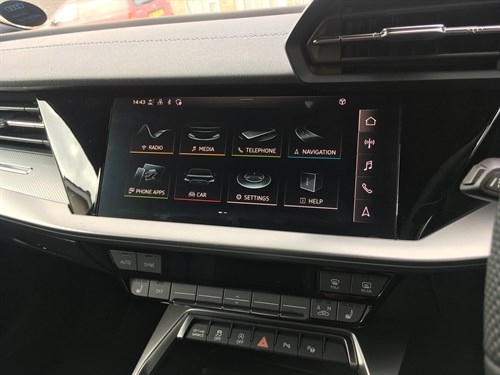
A feature that takes a far more straightforward approach is the warning system that tells you if your phone is still plugged in when you leave the vehicle - in the form of a literal voice announcement. Some may find that annoying, but personally I appreciate it, given how often, with the modern-day convention of relying on phones for in-car entertainment, I've walked several minutes away from the vehicle only to realise that my mobile is still ensconced on the centre console. If you do find it annoying, there's an option to switch it off.
As for the rest of the interior, it's a thumbs up from me. When the A3 launched, some reviews complained of sub-par plastics being fitted, but you have to pay close attention to notice them, and a far bigger impression is made by the consistently high quality of the fit and finish, with a satisfyingly substantial click to all the switches. The steering wheel is good too - reassuringly chunky without being cumbersome.
1st Report: Audi you do?
A lot of things have changed in 2020, but one thing that hasn't is the decline in new diesel car sales. The SMMT says that so far in 2020, diesel has taken just 17.7% of the market, down from 25.2% in 2019, which itself came on the back of years of falls post-dieselgate.
That might make it seem like the diesel Audi A3, which has just joined our fleet, is on a hiding to nothing - particularly when you consider the last diesel car I ran in this segment, the Mazda3, was actually discontinued by its manufacturer during the test period due to a lack of demand. And the A3's engine doesn't even have a fuel-saving mild-hybrid system of the sort that has cropped up lately with other diesel Audis.
But the A3 does have two things in its favour. Firstly, that despite the bad publicity around the fuel, we at Business Car still think that with its good fuel economy and CO2 emissions diesel remains the right choice for many fleet applications. And secondly, as for many people, my own personal work journey profile this year has been greatly amended. Before, a large chunk of my mileage in long-term test cars was spent on rush hour commutes to the office, but like millions of others this has now disappeared, with homeworking becoming the norm. What's left therefore is the long-distance trips - three-hour slogs up the motorway network to attend the new breed of socially distanced media events. Potentially, it's the ideal proposition for a diesel, so I'm expecting impressive figures from our fuel economy calculations over the coming months.
Engine aside, this is, of course, the latest A3 that arrived on the market earlier this year, in close proximity to its platform-sharing VW Group cousins the Volkswagen Golf, Seat Leon and Skoda Octavia. Unsurprisingly, the Audi is the most expensive of those four, so what I'm looking for are tangible reasons to choose it beyond just having four rings on the front grille. It's in the sporty S Line equipment grade, which certainly helps it to make a good first impression, with bespoke S Line bumpers, a roof spoiler, chrome tailpipes and privacy glass among its cosmetic flourishes. However, I'm also pleased that as a no-cost option the A3's standard suspension has been retained, rather than the lowered sports suspension that is normally included with S Line. OK, cars fitted with that should have sharper handling, but with other Audis I've tried that also means compromised ride comfort, and with the diesel engine making the car feel naturally more suited to cruising than B-road blasting, the regular set-up seems like the right choice.
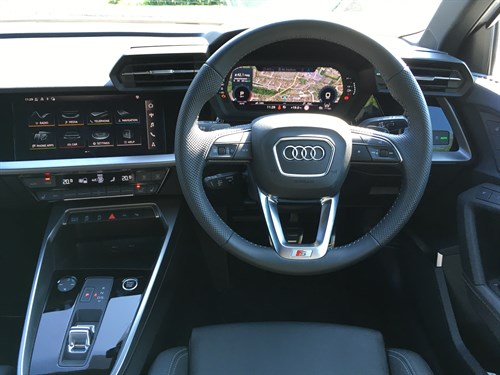
Inside, Audi's Virtual Cockpit display is standard throughout the range, along with a 10.1in infotainment touchscreen. It's a tech showcase, and does look good. But then the interior should be impressive, given the basic price of the car in this spec is more than £31,000, and if anything the extensive list of options fitted reveals some shortcomings in the standard equipment list - making you pay £330 extra for heated front seats, for example, feels a bit stingy. With the options included the price comes to over £37K - a chunky figure indeed for a lower-medium hatch, and one that creates high expectations for the A3 to live up to.
Standard equipment: LED headlights and tail lights, privacy glass, front and rear centre armrest, stainless steel pedals and front footrest, selectable drive modes, dual-zone climate control, auto dimming and frameless rear-view mirror, leather multifunction steering wheel, USB-A port, USB-C port, smartphone interface, 10.1in touchscreen with satnav, 10.25in Virtual Cockpit display, Audi Connect navigation and infotainment services (three-year subscription), cruise control, rear parking sensors, autonomous emergency braking, collision avoidance assistant, lane departure warning, auto lights and wipers
Options: Glacier White metallic paint (£575), driver assistance pack (£1,405), 18in five-spoke Y-design alloy wheels in graphite (£145, not normally available in UK), memory feature for driver (£1,150), Matrix LED exterior lighting pack (£675), storage pack (£175), extended ambient lighting pack (£110), heated front seats (£330), four-way front seat lumbar support (£260), progressive steering (£240), Bang & Olufsen premium sound system 3D sound (£760), standard suspension (no extra cost)










